World Hair Transplant Repair Day is On the Way – Get the Details
The first thing patients should know about a hair transplant is that it needs to be performed by an experienced and board-certified surgeon who has a proven history of high-quality results that restore the hairline and give a person a more youthful look. Unfortunately, there are a number of patients who have been victims of unlicensed individuals who have operated on their scalp. These unlicensed individuals might lack the proper training and they might not even be a licensed doctor or authorized to perform hair transplant surgery. In an effort to assist the large number of patients who have been operated on by an unlicensed individual (in a fraudulent manner or they were simply unaware of the lack of medical credentials on the part of the person), the International Society of Hair Restoration Surgery (ISHRS) is hosting its second annual “World Hair Transplant Repair Day” on November 11th of this year.
Worldwide Event to Repair Hair Transplants
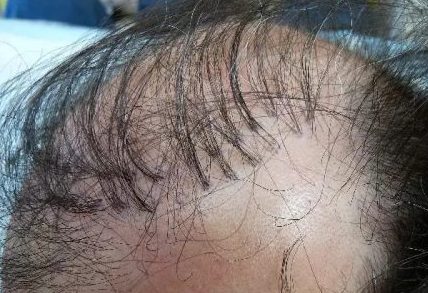 This event, which will take place across the globe, is part of the “Fight The FIGHT” global consumer awareness campaign of the International Society of Hair Restoration Surgery. The “FIGHT” in “Fight The Fight” is an acronym that stands for Fight the Fraudulent, Illicit, and Global Hair Transplants. This campaign was created and designed to educate, as well as help, those who have been victims of a hair transplant performed by someone who was not authorized to perform the surgery or was lacking in the skills necessary to provide the desired natural results.
This event, which will take place across the globe, is part of the “Fight The FIGHT” global consumer awareness campaign of the International Society of Hair Restoration Surgery. The “FIGHT” in “Fight The Fight” is an acronym that stands for Fight the Fraudulent, Illicit, and Global Hair Transplants. This campaign was created and designed to educate, as well as help, those who have been victims of a hair transplant performed by someone who was not authorized to perform the surgery or was lacking in the skills necessary to provide the desired natural results.
Anyone who was a victim of this practice is invited to reach out on an individual basis to volunteer physicians who are participating in the event. These victims can reach out through the website of the campaign, located at HairRepairDay.org, for an opportunity to receive a restorative hair restoration procedure free of charge (pro bono) from one of the participating doctors listed on the website.
In a statement released to the press, Nilofer Farjo, MBChB FISHRS, president of the ISHRS, said, “The ISHRS is committed to raising awareness of this widespread problem of unqualified technicians illegally performing hair transplant procedures, oftentimes resulting in irreparable damage to unsuspecting patients.” Farjo added, “Consequences of this unscrupulous practice include permanent scarring, infection, visible donor scarring, poor growth, thin patches of hair or bald spots, and hair depletion from over-harvested donor area – all of which can be difficult, and in some cases impossible, to correct.”
Hair Restoration Surgery and Misleading “Experts”
 According to the ISHRS, there are many clinics across the globe that promote themselves as experts in hair restoration. By making the claim that they are experts when it comes to restoring the hairline, they are able to get new patients through the promise of cheaper prices. Plus, the advertising they utilize is filled with misleading information. There are also many cases when a physician is not even present in the medical operating room to perform the surgery.
According to the ISHRS, there are many clinics across the globe that promote themselves as experts in hair restoration. By making the claim that they are experts when it comes to restoring the hairline, they are able to get new patients through the promise of cheaper prices. Plus, the advertising they utilize is filled with misleading information. There are also many cases when a physician is not even present in the medical operating room to perform the surgery.
Patients who are interested in having a hair transplant should know that the number of hair transplant surgeries that have been performed has increased in the past several years along with the growth of fraudulent clinics who want to take advantage of the number of patients looking to correct their hair loss in a permanent manner.
In a recent market survey conducted by the ISHRS, there was a total of 51% of ISHRS members who reported the existence of Black Market hair transplant clinics in the cities where they are located. It was also reported that, as of 2021, there was a total of 5.4% of hair restoration patients who were looking to have a treatment to repair the results of a previous surgery that occurred in an office where the physician did not perform the surgery. This statistic was an increase over the 4.2% that was reported in 2019.
Hair Transplants – What to Ask a Qualified Surgeon
If a hair transplant is performed by a surgeon who is qualified and board-certified, the procedure is an excellent option to address the issue of hair loss on the scalp of a patient. In order to ensure patients are able to get the information they need from their surgeon of choice; they should take the time (in advance) to write down any questions they have for the surgeon. Having the questions written in advance means a patient will not accidentally forget to ask something that might be on their mind about the process. Plus, it gives the person wanting to have a hair transplant the chance to ask the doctor (in-person) if he/she will be the one that performs the surgery.
Patients should also ask to see “before and after” photos of previous patients who have been treated by the surgeon of choice. The viewing of the photos will give a better idea about the type of results that can be expected after the doctor performs the hair restoration procedure.
To emphasize the importance of chatting with the preferred surgeon and making sure the physician of choice will be the one performing the surgery, Ricardo Mejia, MD, chair of the ISHRS Communications and Public Education Committee, said, “The best advice to avoid being a victim of a physician that chooses to let someone less qualified and unlicensed do your surgery is to ask questions and insist the doctor be the one to perform the surgery. Do your homework and don’t settle for less.”
Hair Loss Research and Treatment Making News in 2020
It seems like each year bring news that promises an end to hair loss or a new discovery that might eventually lead to hair loss being a thing of the past. Hair loss can be the result of genetics, certain medications and even some form of trauma to the scalp. In order to combat hair loss, both male and female patients look for hair restoration methods that can provide them with the full hairline they desire. Let’s take a look at the latest medical innovations, and even some that might not be all that new, being promoted as a way to end hair loss once and for all.
Hair Loss Research and Treatments in 2020
The idea of hair follicle cloning has been around since the 1990s but it is still being discussed as a possible means to end hair loss. The cloning of hair follicles can best be described as hair multiplication. Several hair follicles can be produced from a single hair in a medical lab or in vivo AKA inside the body. The science behind hair cloning has been described as the follicles getting connected to the existing stem cells on the scalp of a patient. In other words, the hair that is newly grown in a lab can become one with the scalp and eventually grow directly in the scalp like any natural hair.
There has been some success in the use of this process with animal models. However, there are multiple additional phases that will need to be completed in human models before doctors and patients are able to see the long term effects and overall safety of this possible hair restoration method. The use of hair cloning in real world situations is not available to the general public so it will be (at least) a little while before this hair loss method is normalized and available for patients to utilize to address their balding scalp.
Biotechnology Cure for Hair Loss and Balding
 Patients should be aware that hair restoration can provide a full and healthy hairline in the area being treated on the scalp. The hair that is transplanted is permanent and will not be subject to balding in the future. Unfortunately, this does not prevent balding from being a possibility on other areas of the scalp as a person continues to age.
Patients should be aware that hair restoration can provide a full and healthy hairline in the area being treated on the scalp. The hair that is transplanted is permanent and will not be subject to balding in the future. Unfortunately, this does not prevent balding from being a possibility on other areas of the scalp as a person continues to age.
The issue of balding for patients of all genders and ages has not been solved or eliminated. Companies that are located in the biotechnology sphere have been working to find a cure to the issue of balding as well as simply trying to determine if baldness can be eliminated and cured. For example, Follicum, a Swedish biotech company whose lead candidate drug for the treatment of hair loss is currently in Phase II clinical trials, discovered a possible treatment while studying treatments for arteriosclerosis which is when the walls of the arteries thicken and harden as a person gets older. Scientists at Lund University in Sweden discovered that a variant of a protein known as osteopontin, which naturally occurs in the human body, might increase hair growth in mice.
Further studies have shown that this protein variant can target a very specific point or area on the hair follicle cells which gives it the ability to accelerate the hair cycle from the resting to the growth phase. This ability allows the protein variant to stimulate the hair follicles in the dormant phase to start producing hair in the growth phase.
To date, Follicum has tested an injectable form of treatment in two clinical trials that both lasted for a period of three months. The results from the clinical trials both showed patients reporting increased hair density. A new test phase involving a version of the product that is a topical cream is expected to begin later in 2020.
Hair Transplant to Treat Baldness
Before we go any further, this is not a mistake. While hair transplants have been used for years to address issues of balding on the scalp, hair restoration through hair transplants is always evolving as new methods of performing hair transplants are constantly being tested and put into use for patients. For example, our practice performs a hair restoration method, pioneered and perfected by Dr. Mohebi, known as Celebrity Hair Transplant. This Los Angeles FUE hair transplant method uses a limited number of grafts so there is minimal downtime and little to no detectability.
Research is always being performed on how to better perform hair transplants and provide even better results for patients. Even with the other hair restoration methods discussed above being studied and tested, a hair transplant is still the best and most effective method of providing patients with the hairline of their dreams.
While there are many efforts being made to address and solve the issue of balding for patients, further studies and tests are needed on hair restoration methods that are not hair transplants. Patients that are interested in learning more about the hair restoration options available to them should schedule a consultation appointment with our office to discuss your hair restoration goals.
MA
Research Suggests Balding Men at Higher Risk of Severe Coronavirus
The COVID-19 pandemic has impacted men and women of all races and ages. While coronavirus often does not seem to discriminate between those suffering from the disease, a recent study seems to show a strong connection between men that are balding, AKA suffering from hair loss, and severe cases of coronavirus.
Researchers Comment on Balding Men and Coronavirus
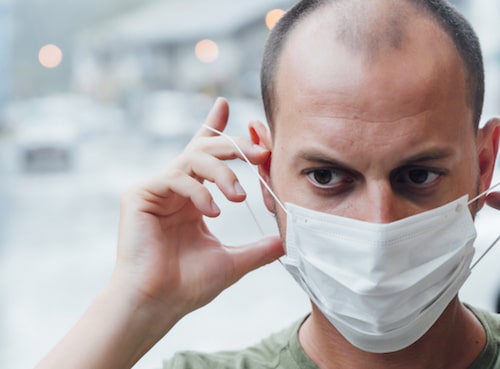 The link between the severity of COVID-19 and baldness has been getting more attention in the past few months. There are some researchers who believe that the link between balding and coronavirus is so strong that they are asking for baldness to be listed as a risk factor for COVID-19 and they want it to be referred to as the “Gabrin sign”.
The link between the severity of COVID-19 and baldness has been getting more attention in the past few months. There are some researchers who believe that the link between balding and coronavirus is so strong that they are asking for baldness to be listed as a risk factor for COVID-19 and they want it to be referred to as the “Gabrin sign”.
The reason that the researchers want baldness to be listed as a risk factor with this name stems from the death of Dr. Frank Gabrin who was the first physician in the United States to die from coronavirus. In addition, Dr. Gabrin was also bald and this is another reason the researchers want to name the risk factor after him.
Professor Carlos Wambler of Brown University, as well as the lead author of the study, told The Telegraph newspaper, “We really think that baldness is a perfect predictor of severity.”
Research Connecting Balding Men and Coronavirus
There have been some recent reports where scientists have made a hypothesis that states coronavirus is much deadlier for men than women thanks to testosterone. Thankfully, there does appear to be some help for male patients when it comes to battling coronavirus.
For example, a group of Italian doctors have found patients that were previously given androgen deprivation therapy, which can greatly reduce testosterone levels, are four times less likely to die from the coronavirus disease.
In addition, a specific protein, TMPRSS2, is increased by testosterone which leads scientists to believe that the virus might be able to use this protein in order to unlock cells.
A research team located at London’s Institute for Cancer Research is working to further examine the link. Plus, researchers at the University of California, Los Angeles are taking an in-depth look at testosterone-blocking therapy as a way to help develop further coronavirus treatments.
Testosterone and Coronavirus
Testosterone in the body can produce dihydrotestosterone (DHT) and this can lead to hair loss for a person. Thanks to the data showing the link between baldness and the severity of the coronavirus symptoms, there is a possibility that treatments designed to reduce the amount of testosterone can be used to slow down the virus.
Medical Officials Speak Out about COVID-19
In a recent interview with Science Magazine, Howard Soule, the executive vice president at the Prostate Cancer Foundation, said “Everybody is chasing a link between androgens and the outcome of COVID-19.
In addition, Karen Stalbow, the Head of Policy at Prostate Cancer UK, recently stated “There have been several recent pieces of research which indicate there may be a link between male hormones and increased risk of COVID-19. This has led some researchers to investigate whether hormone therapies commonly used to treat prostate cancer, such as enzalutamide, could reduce this risk.
Stalbow noted that most of the research has been in a lab and there is some conflicting evidence over the hormone therapies having the same impact in the lungs as they would have in the prostate cells of a patient. She also feels that, even with the current clinical studies being conducted, there is a need for more evidence about whether or not hormone therapies are a valid and effective COVID-19 treatment.
MA
FUE Hair Transplant – Everything You Need to Know

Recently, Dr. Mohebi was interviewed by Cosmetic Town to break down everything you need to know about one of the most popular hair restoration procedures: the FUE Hair Transplant. Enjoy the full interview and breakdown below!
What is an FUE Hair Transplant?
FUE stands for follicular unit extraction or follicular unit excision. This refers to when we go with a special device and try to remove follicular units one at a time without making a big cut or removing a big piece of the skin. This is so the grafts that we remove are barely bigger than the size of the follicular units themselves.
Who is the best candidate for an FUE procedure?
Anybody who is a good candidate for a hair transplant is a good candidate for FUE too. In fact, the FUE procedure can be an answer for people who are not good candidates for other types of hair restoration procedures. For example, in addition to the scalp hair, we can remove hair from the beard or any parts of the body, contrary to other types of hair transplants. So pretty much anywhere in your body that you have hair, we can go individually remove them and place them wherever we want.
How long do the results of FUE hair transplants last?
When done correctly, FUE hair transplant (just like other hair transplant procedures if the grafts are selected properly from the permanent zone) grafts are expected to stay for the rest of the patient’s life.
Advantages of FUE Hair Transplant
The advantage of doing a hair transplant via FUE method is that you don’t have to cut a piece of the skin. This means there’s no cutting involved, no suturing, stapling, no scar in the back and almost no pain or tightness after the procedure. The older method, hair transplants used to have to cut a strip of the skin out and we have to close them and people have a line of a scar that is permanent. And also there’s some tightness involved that people have to go through the next few days. FUE, however, induces almost no pain after the procedure and there’s no cutting or suturing or scaring.
Both men and women can get FUE hair transplants as long as they can have the preparation for the donor area that we have different methods of that be done.
Patient FUE Testimonial
“My procedure today went really well. Dr. Mohebi and I discussed a couple of things when I first got in. He took out a couple of devices and went over a few things on my hair and said, ‘This would be good for the future.’ Checked out where a good hairline would be, what would need to be done in order to keep it at its fullness. And then it was basically from there straight to the room and everything went good. No discomfort at all. The local anesthetic was great. I didn’t really feel any pain whatsoever. They were very cognizant if I did have any pain to go ahead and nip it in the bud and make it as comfortable as possible.” – Actual Patient
FUE Procedure Breakdown
Hairline Design
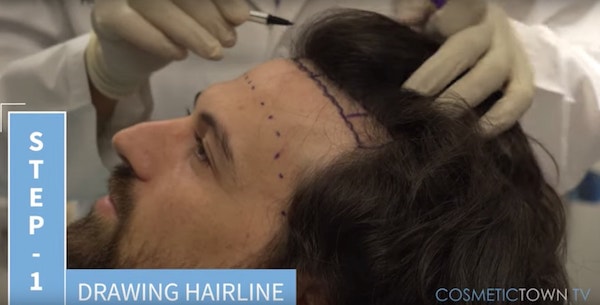
The first step of the procedure is to have the patient come into the office to design the hairline. We make sure that the hairline is something that’s appropriate for the patient’s sex, facial features, and age. These are all critical aspects for the hairline design. Designing the hairline is the artistic aspect of the procedure. If not done correctly, it will give a result that will show that this is transplanted hair rather than something that nobody can detect.
FUE Transplant Technology & Equipment

The device that we use for the extraction of grafts is called Trivellini System. The Trivellini System is a multiphasic device that goes through different layers of the skin with different modes. That way we can cut through the skin. For example, we start with rotation with maximum power and keep it at 300 milliseconds to allow the point to go to the skin.
Then we switch to oscillation. I use 240 degrees and for power, I use 80%. For the time I go, usually 400 sometimes 500 milliseconds. On the top, you see a smart react and on this side, we have this delay time. I set it up for 300 milliseconds that the system realizes that it has to start working after 300 milliseconds after I touch the skin. So smart react is the smart system that I let the system see where we have to start doing this.
Next, we start with rotation osculation we can add another mode. For this, I to use vibration, keeping my vibration on 60% for 200 milliseconds. The combination of rotation, oscillation, vibration will get me through different layers of the skin, cut the skin perfectly and keep the grafts in perfect shape.
Prepping Patients for FUE
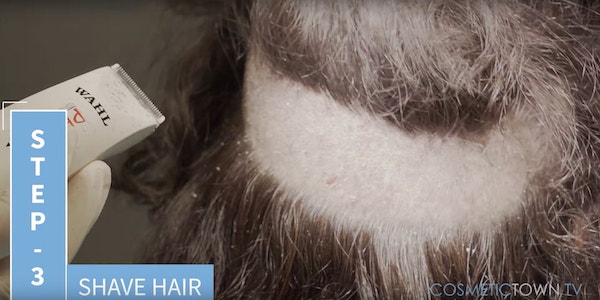
When we take patients to the procedure room is the time that we have to prep patients for the procedure. We usually start with shaving on the donor area, but this depends on each individual procedure. We don’t always have to shave their heads because some people choose to go with the non-shaven method. In this case, we do shaving the donor area just as layer shaving. So we just shave one layer of the scalp on the back and the long hair is long enough to cover it so patients won’t miss anything. In the recipient area also we do shaving if we can. If patients are okay with that, especially people with long hair, they can comb the hair over and cover it. That being said, we usually prefer to shave it a little bit so we can be able to be more precise and dense pack the grafts into the recipient area better.
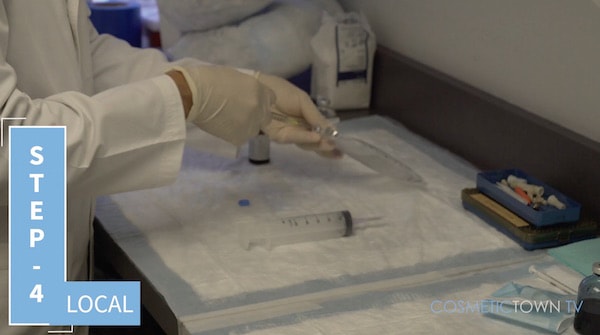
The next step is to administer the local anesthesia. When the patient is comfortable when the short-term sedation is onboard. It could be laughing gas or a shot that we gave them. People are comfortable with doing the local anesthesia. So basically even those little pricks that is involved with a little infiltration of local, we don’t want people to feel. At that point we are using a special fine needle and we go around the scalp and give them local anesthesia, it’s called ring block. That blocks all the nerves that brings the sensation to the scalp. By doing that, patients are not feeling anything throughout the process. We may need to repeat this process of locking infiltration of local anesthesia during the procedure too.
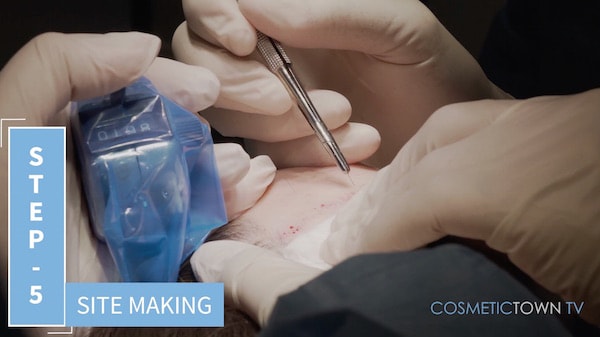
Site making is the next step that we are basically making small incisions that grafts will be placed into. So those incisions are very tiny. We were talking about 0.7 or 0.8 millimeter wounds that will be visible immediately after doing this. But then in a day or two it will be all healed and nobody can see any evidence of them. The depth of them are usually 4 to 4.5 millimeters. So those are teeny holes that we are making that eventually the grafts will be placed into. The reason we do it ahead of time is because we want to have the site, the design all done. So when we are extracting the grafts the technicians can start placing them into the premade sites.
Extraction & Placement
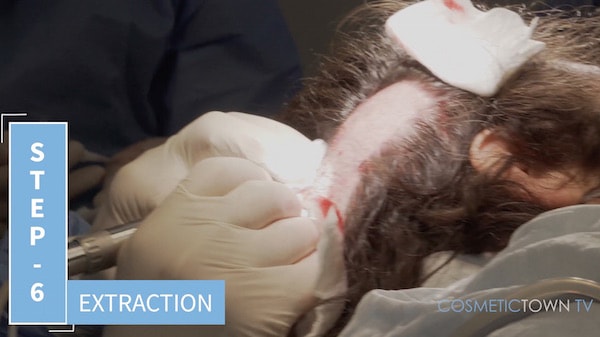
The next step is when we take patients to a different position and start extracting the grafts. We usually do this method it’s called simultaneous extraction and placement, meaning that when we extract the grafts, that technicians will place them into the pre-made sites.
So I start from one side, usually from the right side of the scalp and start extracting going towards the other side. As I’m extracting the grafts with this machine that extracts the grafts my technician follows me and removes them one at a time. Then those grafts are being handed to the counting team at the microscopic station.
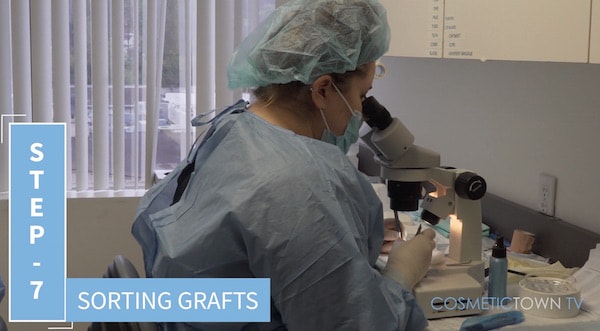
Next step is counting and sorting the grafts under microscope. At this step, a technician will review every single grafts, make sure they are all intact. They will count them in terms of number of hair per graft and have them ready in the group of 20 grafts in a special solution to be removed and start the process of insertion or implantation.
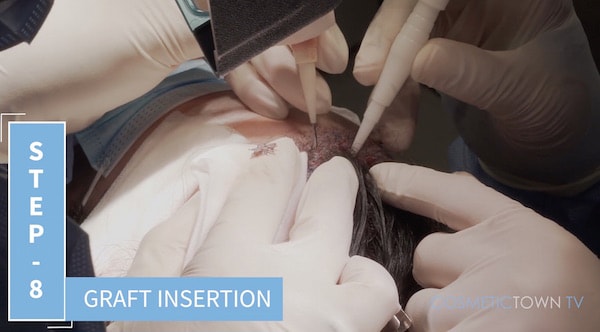
Next step is the insertion of the grafts. At this step, we remove those grafts that are prepared under a microscope and we put them into the implanter. This device, it’s called Mohebi Implanter (Inserter), it is invented by Dr. Mohebi.
So this process is probably the longest process in the whole process of hair restoration because each has to be done under magnification, and the technicians have to find those small incisions that we already made and fill them with the grafts with Mohebi Implanter (Inserter).
Final Inspection
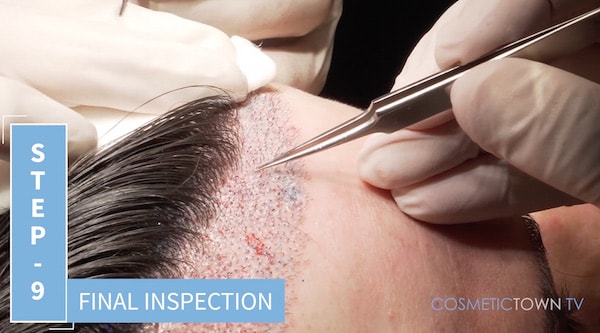
At the end of the process, we’re going to go and do a final inspection to make sure every hole that is supposed to be filled is done. I usually spend some time to go between the grafts. Some of the grafts may need to be rotated. Even the curvature of hair is very important to consider. It’s not just the angle distribution it’s also the curvature of the hair. They all have to be perfectly natural, the way that we see in nature. If I have to add density in certain areas, I’ll also do that. If I have to move some hairs from one area to another, I’ll do that because that’s the last step, that last opportunity that we have to make that hairline look perfect.
How does this procedure change people’s confidence?
It’s a big factor in people’s confidence. Hair restoration can increase people’s confidence and reduce anxiety. Social anxiety can have a major effect on people’s careers, sex lives, and levels of happiness. We’ve seen it on a regular basis in our offices, and if the hair restoration is done properly, it’ll bring back the patient, the look that they always had, or they always wanted. And with it, the patient’s confidence.
Can Women Get Hair Transplants?

Although the vast majority of hair transplants are performed on men, women can get hair transplants, too! At Parsa Mohebi Hair Restoration, we make an effort to shed a light on the subject and get rid of the stigma that hair transplants are a procedure for men only. In this article, we will answer some of the most common questions about female hair transplants, and provide you with the facts!
Statistics For Women’s Hair Transplants
It is true that hair loss is more common in men, but hair loss is a condition that affects both men and women. The statistics show that surgeons treat more men on average than women with respect to treating hair loss with both surgical procedures (hair transplants) and non-surgical procedures. According to the 2017 ISHRS practice consensus, on average, 85.7% of surgical hair loss procedures were performed on men, while 14.3% were performed on women. That being said, the statistics also show a big difference in non-surgical hair restoration treatments with 61% for men with non-surgical hair restoration procedures and 38% for women.

Who is a good candidate for female hair transplants?
In general, females that have male-pattern baldness on the front and sides, but still have good donor density in the back, are good candidates for a hair transplant. On the contrary, females that have female-patterned hair loss with overall thinning are typically not good candidates.
When is Hair Transplant recommended for women?
A hair transplant is recommended for a female patient if they are a good candidate (male-pattern baldness with good donor hair) and their hair loss has begun to affect their life. Here are a few examples of women who were good candidates:
Before And After Female Hair Transplant Examples
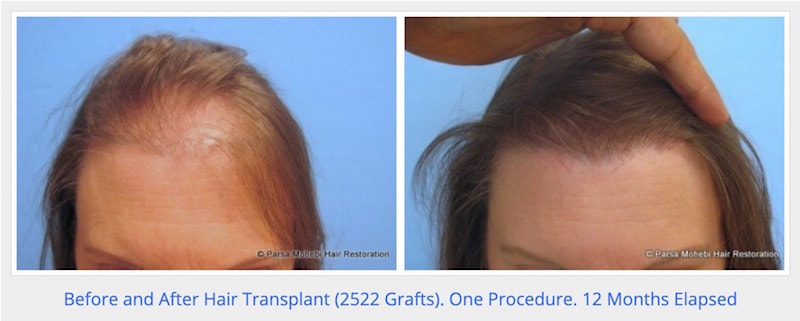
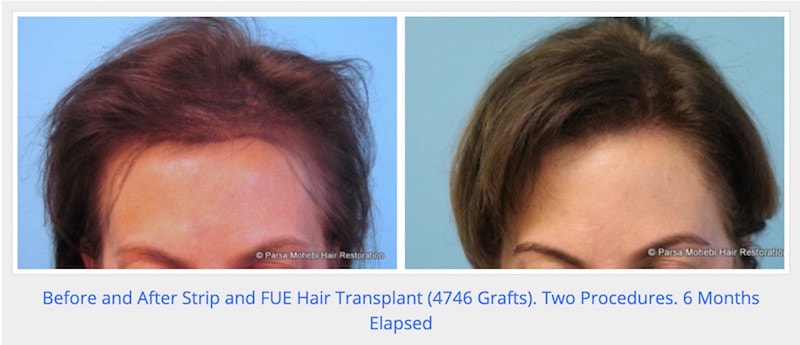
How successful are hair transplants in women?
Hair transplants for women are very successful when the candidate is selected properly. As Dr. Mohebi explains in the video, a microscopic evaluation should first be conducted to determine the type of hair loss they are experiencing. If the patient is determined to fit the criteria of a good candidate, then they will most likely have a successful hair transplant result.
Female Hair Transplant Testimonial
Meet our patient, Nazie. After suffering from an accident, she had lost of her hair and was unsure if she’d ever get it back. As you can see from the video, Dr. Mohebi was able to restore her hair and she looks amazing now! When asked about her feeling on women’s hair transplants, she said, “Hair loss in women is not discussed as much as men but it is a real issue. I don’t see why anyone would live with hair loss.” We couldn’t agree with her more! Women’s hair loss is a very common issue that is treatable. Nazie is an inspiration to women everywhere that want to get a hair transplant but are scared to face the stigma that comes with it. She shows that getting women getting hair transplants is just as acceptable as a man getting them.
Are you ready to take the first step to regain your self-confidence, like our patient, Nazie? Schedule a consultation today!
Hair Transplant Beverly Hills

According to an article by Total Beauty, Beverly Hills topped the list of U.S. Cities with the Most Plastic Surgery, reporting roughly 1 plastic surgeon for every 500 residents. It comes as no surprise that Beverly Hills has the most plastic surgeons per capita since it is located in the hub of Los Angeles- the land of cosmetic excellence and constant self-improvement. And in a city like this, nothing signifies status better than a new and improved self image!
What does this mean for Hair Transplants in Beverly Hills?
Some would argue that the hair is the most important part of one’s image. In fact, it is one of the first things someone notices when they first see you. A full head of hair gives the impression of youth and vitality, attributes that are critical in Beverly Hills. That being said, this makes hair transplantation one of the most sought-after procedures for men and women looking to improve their appearance – especially in Beverly Hills. Just like other specialties, there are countless hair restoration surgeons in Beverly Hills to choose from. With all of the options out there, how do you know where to find the hair transplant Beverly Hills trusts?
Whether you’re experiencing active hair loss or simply want to improve on your hairline and look younger, Beverly Hills is one of the best places in the world to go to get a hair transplant. With so many doctors in such a small proximity, hair restoration doctors in Beverly Hills are known to keep up with the latest practices and also have some of the most artistic approaches to hair transplantation. If you want to look your best, the hair restoration specialists in Beverly Hills is where you want to go!

Our Beverly Hills Hair Restoration Office
Our Beverly Hills Hair Restoration Office is conveniently located in the heart of Beverly Hills, CA. Our practice is always striving to improve the quality of our service and maintain 100% customer satisfaction. Our new office is very modern and has the look and feel of an art gallery while being equipped with amenities that guarantee a pleasant visit for all of our patients. Visiting the office of any kind of doctor is normally a visit to a boring and rather generic building. Our new penthouse suite location is designed to be inviting and our patients might not even feel like they are in a doctor’s office! We strive to make the hair restoration process as comfortable as possible. For us, that means creating a space to put our patients at ease as well as specializing in the hair transplant Beverly Hills turns to.
In a city where one’s physical appearance signifies status, how do you feel about the message your hair is giving? If you’re not looking as good as you feel, it may be time to consider the hair transplant Beverly Hills trusts. Schedule a consultation at our Beverly Hills office today!
More than The Length of a Hair’s Difference
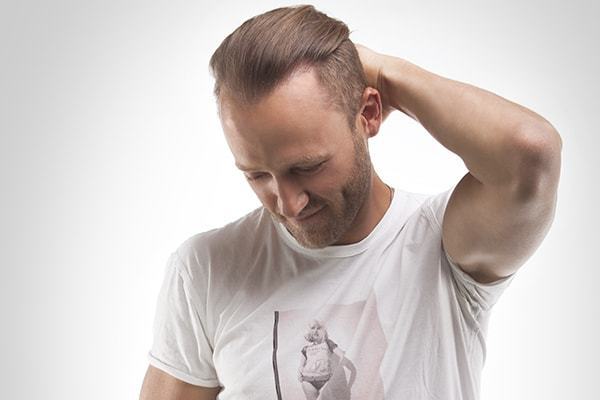 While hairline reduction and hair transplants can both lower the hairline, there are quite a few differences in the procedures. How does a patient decide which procedure is best for them? The decision eventually comes down to a variety of factors:
While hairline reduction and hair transplants can both lower the hairline, there are quite a few differences in the procedures. How does a patient decide which procedure is best for them? The decision eventually comes down to a variety of factors:
- A consultation with a good hair transplant doctor
- The expectations the patient has before undergoing a procedure
- Which of the two procedures best fits their expectations and their individual needs
When a patient is considering having a procedure to lower his or her hairline, it’s important to know the different advantages of the two procedures:
Hairline Reduction Advantages:
The first advantage of a hairline reduction is the fact that it is a quick procedure.
A hairline reduction procedure can also create a high density hairline which might be desirable by many patients.
Advantages of a Hair Transplant to Lower a Hairline:
One advantage of doing a hair transplant to lower the hairline is that the final result is more natural looking. A good hair transplant surgeon can create a very natural looking hairline that reflects the normal transition of hair density.
A hair transplant procedure avoids the linear scar that a hairline lowering procedure creates. Instead of a scar, the patient can expect a natural looking transitional zone in their hairline with a hair transplant. A hair transplant to lower the hairline also allows for more flexibility with the placement of the hair/overall hair direction and the curvature in which the surgeon can mimic a perfectly natural hairline.
What Is The Next Step?
The next step for a patient is to study the advantages of the options listed above to determine which of the options best fits their needs. Once the patient has determined which technique is best for them, they should find and consult with a good doctor to determine if they are a viable candidate for either a hairline reduction or a hair transplant to lower the hairline.
Is Beard to Scalp Hair Transplant the Future?
Beard to scalp hair transplants have become more common. Most of these are performed to correct male pattern baldness. Encouraged by our strategies and new findings on how to use facial hair, we have performed numerous beard to scalp hair transplants in the last two years with great results. But, the procedure may need to be performed more than once on many of these patients to ensure full coverage of the balding area. Luckily, a beard to scalp hair transplant can provide patients with a plentiful source of hair. This is especially important for men who don’t have sufficient donor hair due to low density or extensive balding areas that need coverage.
Why has beard to scalp transplant been on the rise?
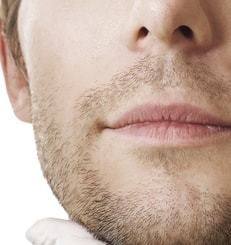 One reason is because our improved understanding of the anatomy of the hair follicular units has furthered the dynamics involved in removing grafts individually. The other reason is that our techniques for extracting follicular units has developed, allowing us to refine the extraction methods from different parts of the body. Previously, extracting hair from the face and implanting it into the scalp was a daunting task that frequently ended with poor results. Now, because of the change in tactics and FUE devices, it is much less demanding to harvest hair from the skin of different parts of the body. Comparing those hairs from different parts of the body like the face, limbs, genitalia, and torso, has taught us that the facial hair is most like the hairs on the scalp. Beard hair has a life cycle, shaft thickness, and length of growth that is very similar to the scalp hair.
One reason is because our improved understanding of the anatomy of the hair follicular units has furthered the dynamics involved in removing grafts individually. The other reason is that our techniques for extracting follicular units has developed, allowing us to refine the extraction methods from different parts of the body. Previously, extracting hair from the face and implanting it into the scalp was a daunting task that frequently ended with poor results. Now, because of the change in tactics and FUE devices, it is much less demanding to harvest hair from the skin of different parts of the body. Comparing those hairs from different parts of the body like the face, limbs, genitalia, and torso, has taught us that the facial hair is most like the hairs on the scalp. Beard hair has a life cycle, shaft thickness, and length of growth that is very similar to the scalp hair.
Our expanding knowledge of the tools used and the advanced strategies has also made it possible to use facial hair to restore balding regions on the scalp more efficient. In the past, the use of bigger punch sizes made for a bigger wound surface area that prompted healing problems such as, scar development and hypopigmentation of the skin. A deeper insertion of the punches used by older methods led to low-level transections of beard follicles. Low-level transection resulted in a higher number of ingrown hairs in the donor area of the face. Development of ingrown hairs is an extremely undesirable complication of a beard to scalp hair transplant, which previously restricted the utilization of facial hair for restoration of the balding region. Incision depth control and utilization of smaller punch sizes have lessened such complications, making beard hair an extraordinary source for hair restoration for many men.
Beard hair to scalp transplantation has its own limitations
There are men who can’t grow facial hair or have a very sparse beard. Some men are not allowed to shave or trim their facial hair due to social or religious reasons. Many men would like to keep the option to grow beard in the future. Extraction of facial hair for these individuals is still a possibility but, the donor area would be limited to the neck and beneath the mandibular line. Despite of the limited donor area in these individuals, extraction of hair from these zones can provide a decent number of suitable hairs that can restore a good portion of the balding area furthering weapons used in the restoration of hair on those suffering from hair loss.